Lorwyn–Shadowmoor: Difference between revisions
>David Brasher2 (Typos, punctuation, clarity.) |
>Jledes No edit summary |
||
| Line 230: | Line 230: | ||
===Lorwyn=== | ===Lorwyn=== | ||
{{in-game | {{in-game | ||
|associated= | |||
* <c>Invasion of Lorwyn</c> | |||
|referred= | |referred= | ||
* <c>Ancient Amphitheater</c> | * <c>Ancient Amphitheater</c> | ||
Revision as of 20:29, 19 February 2023
| Lorwyn–Shadowmoor | |
|---|---|
|
[[File:{{#setmainimage:Visions of lorwyn.jpg}}|250px]] | |
| Information | |
| First seen | Lorwyn |
| Last seen | Commander Legends |
| Rabiah Scale | 6[1] |
| Status | Fused; otherwise unknown |
Lorwyn–Shadowmoor was a plane with two aspects. While Lorwyn represents day, Shadowmoor is night. Lorwyn switched to Shadowmoor cyclically every 300 years,[2] an unnatural event triggered by the Great Aurora.
Lorwyn
Lorwyn is one of two aspects of the plane Lorwyn–Shadowmoor, and the setting of the Lorwyn block. The plane is small, temperate, and believed to be flat.[3] The known portion of the plane, known as the Blessed Nation, is heavily forested and ringed by high mountains, outside of which lays the mysterious Primal Beyond. The world has no oceans or large lakes; all of its water comes from a system of rivers and streams connected by the subterranean Dark Meanders.[4] Lorwyn exists in perpetual midsummer and eternal daytime, though its denizens still operate on a daily cycle. The plane observes dawn, noon, and dusk, with no night, with its day beginning when the sun grazes the eastern horizon and ending as it grazes the western.[5][6][7][8]
Currency on Lorwyn is composed of "threads" of precious metal, in denominations of copper, silver, and gold, grouped in size into threads, ropes, and coils.[9]
Creatures of Lorwyn
The indigenous wildlife of the Lorwyn is dominated by eight sapient races: elves, kithkin, merrows, flamekin, boggarts, treefolk, giants and faeries. Lorwyn is one of the few known places in the multiverse where humans do not occur naturally.[10][11][12] In addition, Lorwyn supports a menagerie of animal and supernatural life, including wisents, springjacks, cervins, a semisapient race of mimics known as changelings and the majestic greater elementals. All of them thrive in Lorwyn's temperate environment and unending growing season, preserving the plane's character as an unspoiled natural wilderness.[10]
Each of the nine races (including the Changelings), known as the Tribes, live in an uneasy state of peace; skirmishes and small battles occur from time to time, but full-scale war is unknown. The Tribes are highly provincial and distrustful of those outside their race; all are wary of the cruel and powerful elves, who functions as the plane's de facto rulers.
Lorwyn is a backwater world rarely visited by planeswalkers. Those who know of its existence regard it as an idyllic paradise. Late in Lorwyn's history, the barriers between the Tribes began to break down as individuals from different races came together into new tribes based on common goals (soldiers, wizards, and so on).
Boggarts
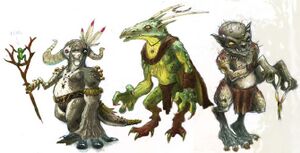
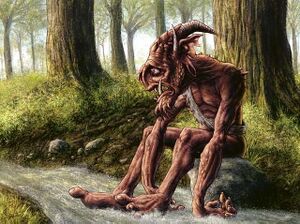
Lorwyn's race of goblins are called boggarts. Boggarts have a greater diversity of morphology than other planes' races and sub-clans of goblins. Some of them have curving horns, others have stubby ones or none at all. Some of them have long snouts or goat-like muzzles. Some have broad, floppy ears; some have sharp points. Their skin varies from green to blue to beige to purple to red.[13] Their teeth are magical and can imbue curses on bite victims.[7]
Boggarts are organized into warrens:
- Stinkdrinker warren, known for its stockpile of stolen goods and its boggarts' penchant for sneaking past even giants to steal their prizes.
- Squeaking Pie warren, known for its culinary adventurousness. Boggarts from other warrens often claim Squeaking Pie lineage so they can attend their Footbottom Feasts, which are widely thought to have the tastiest food. The warren's recipes are its most prized possessions, and its boggarts will go to any lengths to find bizarre new recipes and ingredients. The warren is led by Auntie Jowl, who raises the mice that often end up in the warren's famous savory pies.[14]
- Mudbutton warren, a particularly chaotic and loud warren that appreciates a good party — even if comes at the expense of a few of their members
- Frogtosser warren, a group of boggarts so emotionally changeable that the other warrens think them insane.[13]
Boggart warrens are led by nominal leaders called Aunties. The Auntie is usually the oldest boggart in the warren and is usually female (some are male, yet are still called "Auntie"). The Auntie knows many tales, like fables, that they tell to educate their warren, pass on crucial boggart teachings, and adjudicate disputes. The most famous Auntie fables are about Auntie Grub, a folk hero to the boggarts, and probably a real ancestor. Auntie Grub's tales are particularly helpful for informing young boggarts about racial enemies, dangerous predators, poisonous plants, fungi, and the like.[13]
Boggarts are described as being "collectors of sensation",[15] and that, "while they aren't particularly intelligent thinkers, they are extremely perceptive, in that they perceive a lot." [13] When it comes to arming themselves, they improvise what they can't steal.[16]
About the only law in boggart culture is the pressure to share new sensations with others of their kind. A boggart that refuses to share — a hoarder — will be cast out of boggart society for the sin of keeping a new treasure to themselves. Since boggarts are so social and convivial among their own, exile is considered a terrible sentence.[13][17]
Elementals
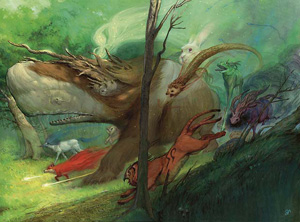
On Lorwyn, abstract entities such as hopes, fears, dreams, and nightmares are just as real as the grass and the trees. These Elementals only exist insofar as do the elements of which they're composed. They vary in prevalence just like the abstract idea underlying them. If elves wage war on giantkind, then many-clawed elementals of warfare and strife can be seen with greater frequency. If merrows launch an expedition to the murky Deep Meanders of their river system, then soggy elementals of the sunken unknown appear. On the other hand, if bloodshed keeps to a minimum across the plane, elementals of violent death may themselves die out — at least, until their time comes again.[18]
Flamekin
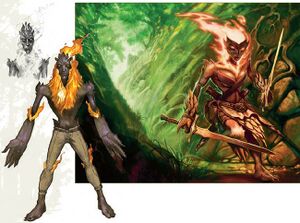
Flamekin are beings of fire and mutable stone whose strong, intense passions drive them to wander the world. The flame of their bodies burns magically cool, but they can choose to burn hot at will. Other races are wary of flamekin and their fickle, fiery natures, a reputation that a group of flamekin called the Brighthearth are working to change. The Brighthearth serve as emissaries of flamekin goodwill to other races, performing useful tasks that require fire, such as smithing. On the other hand, one named Vessifrus is an upstart looking to inspire rebellion among the flamekin. One day he may lead an uprising against the tyranny of the beauty-obsessed elves.
Flamekin have an almost spiritual connection to the more mysterious greater elementals of Lorwyn. Flamekin regard them as totems or demigods that inspire their creative impulses — or frustrate their understanding.[18]
Greater Elementals
Greater Elementals are the living embodiments of the abstract mental ideas and concepts dreamed by the people, such as vigor, hostility, and guile.[19] Vastly different in form from other worlds' elementals, the greater elementals take the form of bizarre combinations of natural animals, many of colossal size. They are beasts that pursue their own simple needs with little concern for Lorwyn's tribal conflicts.
Under normal circumstances, elementals are forces of nature; nothing tames them. But of course, planeswalkers are a different story; with enough mana and effort, they can not only call on the essences of greater elementals but also summon the elementals themselves, along with the power they bring.[18]
Elves
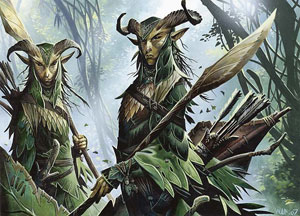
The elves of Lorwyn are aristocratic, ruthless, and predatory.[20] Their society revolves around the laws of beauty, a code that specifies how one's cunning and personal attractiveness determine one's social rank. If you are only moderately beautiful, you are a low-ranking elf. If you are ugly or disfigured — or a non-elf, which is by definition a truly ugly thing to be — then you are an eyeblight, a creature unworthy of respect, or even life. There are four official ranks of elves, determined by the measure of beauty — plus the non-rank of eyeblight for everyone else.[21]
The four social classes are:
- Faultless
- Any elf who possesses the minimum threshold of beauty and grace is granted this basic rank.
- Immaculate
- Dignitaries, VIPs, and higher-level functionaries among elves attain the rank of immaculate.
- Exquisite
- Packmasters (lords of elvish hunting packs) and important courtiers are of exquisite rank. They have the privilege of being able to speak directly to perfects.
- Perfect
- The perfect are elves so beautiful and so shrewd that they rule all other elves. There are only a few of these in the world. Perfects can kill those of low rank with impunity (Note: This rank is "perfect" and not "prefect").[22]
Lorwyn's elves are distinguished by their cultivation of a white flower called moonglove, from which can be derived a potent poison. This poison is deadly even in small amounts, taking down even towering giants. In precisely controlled, highly diluted trace amounts, its necrotizing properties can be used to etch or carve living tissue — such as skin or bark. Also, unlike the elves of other planes, Lorwyn's elves view nature as "something to be improved, cultivated, and if necessary, rearranged." [21]
The elves of Lorwyn often hunt eyeblights, creatures who fail the elves' exacting standards of beauty, and therefore have the lowest status in their eyes. But sometimes, instead, they create vinebred minions from such creatures. For this, the elves can animate a parasitic plant called nettlevines to bind around their victims, creating twisted, but powerful and eminently controllable minions.[23][24]
Fae
No race on Lorwyn is more ubiquitous or mysterious than its faeries. The fae lead short, flitting lives in pursuit of gossip, diversions, and amusing intrigues.[10] Petty and vain, faeries are like petulant children at play. They love to have fun, revel in Lorwyn's eternal midsummer, and follow their whims. But faeries can also be carelessly cruel, capricious, and vindictive.[25]
Faeries travel in small groups of three to six called cliques. They are led by Oona, the enigmatic Queen of the Fae, and a sort of ur-faerie herself. Oona is a flower-like being composed of thousands of petals, constantly budding tiny insect-like faerie children.[26]
It is thought that faeries do not dream, which would explain why they spend so much time harvesting the dreams of others. Faeries can distill these stolen dreams into sparkling energy that they carry around with them.[10] They then bring this "dreamstuff" back to their queen, to both nourish and pollinate her.
The faeries of Lorwyn were the only tribe to be largely unaffected by the Great Aurora, although Oona's consolidation of power did lead some faeries to embrace more hierarchy and maintenance of the status quo, causing them to branch into white.[27][26]
Groundlings
Wingless faeries are called groundlings.
Giants
Giants on Lorwyn are associated with white and red mana. Red giants are short-tempered, territorial, and passionate, while their white counterparts are zealous and stubborn. They are reclusive and lonely, largely due to their need for vast amounts of food, water, and land. Giants will often come to blows when sharing territory, always to the death and often leaving a trail of destruction in their wake — even leveling entire villages during a brawl.[28]
Giants are known to take rich and long slumbers, but they can also enter a trance-like hibernation called the Name Sleep during which they have epic dreams.[29] A giant's first Name Sleep usually occurs at the end of adolescence, but they can also be triggered by a life-changing event or trauma, or by the onset of old age. Young giants derive their surnames from their slumbers, and they may give the dreamer a new purpose in life. A giant's first name is generally two to three syllables and serves as a familiar form of address for friends. All others refer to giants only by their surname, and two giants that share a surname invariably fight for it.[28]
Giants are a race of hermits, arbiters, explorers, and oracles (some are prone to have prophetic visions of the future). Their long life spans give them a particular perception of time, and wisdom that other races respect.[10]
Some Lorwyn giants huddle in mountain caves, often above the cloudline; you can spot a giant's lair by the enormous, rugged dolmen stones built up around the entrance.[30] Others range over Lorwyn with long, loping steps. You can tell a giant's travel route by the man-sized, earth-compressed footprints and lack of vegetation. The death of a giant can be a major event for a region because their lairs are often storehouses of interesting and rare things. Great caravans of treasure seekers and merchants, particularly elves who seek hidden beauty, seek to explore and loot their treasures.[28]
Kithkin
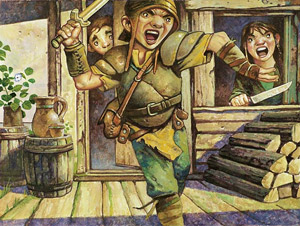
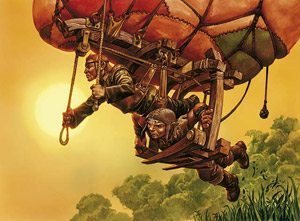
Kithkin are a quick and agile race of small humanoids, mostly associated with white mana. Kithkin clachans (kithkin villages) like the smaller Goldmeadow, larger ones like Burrenton and Cloverdell, or the largest of all, Kinsbaile, are led by cenns (kithkin town leaders). Their society is based on a type of collective consciousness called the thoughtweft. The thoughtweft connects the kithkin by a kind of empathic web, allowing them to share their emotions and thoughts, making them very effective in battle cooperation. Thoughtweft naturally binds kithkin together into tightly knit communities; the better you understand the thoughts and feelings of your fellow townsfolk, the closer you feel to them. Kithkin generally welcome travelers of other races to their clachans, but it's said that if you pick a fight with one kithkin, you're choosing to fight them all.[31]
Kithkin are innovative builders and alchemists, using both craftsmanship and magic to construct melee weapons, armors of leather and bronze, bows, slings, traps, farming equipment, furniture, potions, powder bombs, healing circles, barrier rings, flight auras, and balloon-driven air vehicles.[31]
Kithkin are reverent and superstitious. They venerate the mysterious greater elementals and feel that their movements and actions represent omens for their own lives.
Kithkin celebrate Lammastide, a holiday involving dancing and the tying of ceremonial ribbons. Dancing is an elaborate affair among kithkin, serving to heighten and solidify the bonds of thoughtweft. They also celebrate the Aurora, an annual show of flickering lights that play across Lorwyn's sky, usually with a gathering of multiple clachans and droning cenn speeches.[31]
Merrow
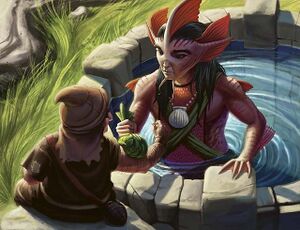
The fish-tailed merfolk of Lorwyn are called merrows. They are the couriers, intermediaries, and merchants of the plane. Given the fishlike anatomy of their lower half, they can't move effectively on land without strong magic. However, they control and maintain the so-called Merrow Lanes, the system of rivers that crisscrosses Lorwyn and connects its furthest-flung points. The Lanes extend overland via rivers and streams, underground via subterranean tunnels, and even up into the town centers of other races via wells. The deepest parts of the subterranean rivers of the Lanes are called the Dark Meanders. Most merrows steer clear of the Meanders due to the lack of light and the ease with which one can get lost.[10]
Merrow society is organized into schools, and each school is led by a reejerey. Known schools include the Silvergill, the Stonybrook, the Paperfin, the Weirwinder, and the Inkfathom Schools. Of these, the Inkfathom School is the most interested in plumbing the Dark Meanders.[10]
Merrows have many different occupations and avocations, and the system of terminology is very important to them, so it's best to study up before your visit. A "rudder" is a merrow guide who knows the Lanes like the back of his scaly hand. "tideshapers" and "aquitects" are merrow mages adept in water magic, who use their abilities to reinforce riverbanks, guide currents, or even alter the course of the Lanes altogether. "Troutherds" and "crawherds" manage schools of river trout and beds of crawfish, respectively. A "landspanner" is a merrow able to leap from one waterway to another one nearby; expert landspanners can hunt large land game this way — or patrol merrow territory for intruders — with spears and spiked nets. A "fallowsage" is a wise elder merrow, many of whom find comfort in the dappled shade of riverside willow trees. A "wellgabber" is an envoy who uses a well to communicate with members of other races.[10]
Treefolk
The treefolk of Lorwyn have the longest lives and longest memories of any of its denizens.[32] Treefolk are born from seeds like any other tree, but they gain sentience and mobility during a process called the Rising. In their youth, treefolk stay in their birth groves, absorbing the wisdom and oral history of their elders. When they mature, they wander the world alone, seeking those worthy of their knowledge or shelter.
The character and roles of treefolk are largely determined by their plant species. Ash, birch, oak, rowan, and black poplar all have different roles in treefolk society. Treefolk risen from poisonous yew trees have all but vanished on Lorwyn, but at this writing, there is still one yew treefolk remaining on the plane: an immensely ancient and knowledgeable treefolk named Colfenor.[10]
Changelings
Lorwyn's shapeshifters are known as changelings. They are a race of relatively harmless, semi-intelligent humanoids who involuntarily change their shape into that of the creatures around them. A changeling's standard appearance is that of a squat, greenish-blue humanoid with slightly scaly skin, large eyes, a translucent body, and frequently a forked tail.[33][34]
Changelings have no culture per se. They don't have technology or art. When they speak, it's incoherent parroting. They are creatures of high magic, but they don't have the intellectual wherewithal to forge an agenda as a race. There are no notable changeling individuals; they are indistinguishable from each other by anyone other than themselves.
Changelings are skilled at mimicry, but they're far from devious or deceptive. Changelings are obvious. No matter what shape a changeling takes, it always has its characteristic opalescent sheen and its translucent look to it. They can't use their transformation abilities to their advantage, because they automatically adapt to whatever forms are near them. Changelings do not substitute themselves for the children of other races, but a faerie or boggart might pull such a prank on an unsuspecting kithkin mother at times.
Changelings can be found all over Lorwyn, in every kind of terrain. They have no proper homeland, but they are associated with a mysterious cavern called Velis Vel, where they convene each year and new changelings are created.[35]
Locations
- Gilt-Leaf Wood
- Glen Elendra
- The Great Forest [36]
- The Honeystone River, drunk dry by the treefolk monk Adair River Span.[32]
- Kithkin clachans:
- The Merrow Lanes (Lorwyn's rivers)
- The Wanderwine
- The Dark Meanders
- The Wanderwine
- The Mountain ranges. Realm of giants, some wanderlust-stricken flamekin, and hostile greater elementals, so exercise caution.
- Amphitheater of Galanda Feudkiller.
- Mount Tanufel
- Porringer Valley
- The Stand of Tulimeer, an outpost of treefolk and other trees attempting to establish a new forest on a rocky outcropping near flamekin lands.[32]
- Velis Vel [36]
Shadowmoor
Shadowmoor, the setting of the Shadowmoor block, is the other facet of the plane Lorwyn–Shadowmoor.[37] Whereas Lorwyn was defined by its greenness, especially its forests, its dark reflection is practically devoid of green.[38][39] In contrast to its daytime aspect, the plane of Shadowmoor exists in perpetual dusk, where the sun is never directly visible, and the only light seems to come from unseen sources.[3] Though the sun is always hidden behind a blanket of cloud, Shadowmoor still observes dawn, dusk, and night, albeit with no noon.[8]
The former inhabitants of Lorwyn don't recall their previous lives and remember having always lived in Shadowmoor. There are, however, a handful of beings who retain their memories; for example, in the storyline's latest Great Aurora: Ashling, Brigid Baeli, Maralen, Oona, the Vendilion Clique, Rosheen Meanderer, and The Sapling.
Another difference between the two planes is that some creatures who are dormant in Lorwyn are active in Shadowmoor, while others now hide from sight on the new plane.[4] Ouphes, korrigans, pucas, kelpies, scarecrows, and nightmarish, mythical beings that had slumbered beneath Lorwyn's surface have reemerged in the ambient night. What races have survived the change have been thoroughly altered by the tainted darkness covering Shadowmoor. In particular, the demeanor of each race has taken a turn for the worse.[40] The kithkin have become withdrawn and distrusting of the other inhabitants of the plane and the boggarts are now violent brutes. The flamekin, now called cinders, have lost their passion and become hateful shadows of themselves; giants have lost their intelligence, and rely in their basic instincts;[41] the merrows are spiteful pirates and raiders who lurk in their murky rivers; the treefolk are warped skeletons of bark and branches; and the playful changelings have become the malicious mimics.
The elves, in contrast, were one tribe to experience a more positive difference. They became the last remnant of Lorwyn's older, idyllic environment. Pressed by hostile conditions, the elves were forced to battle for their very existence. Rather than lording over the plane and oppressing the other species to conform to their values of beauty and grace, the ironic reversal in their situation shifted the elves from arrogance to humbled self-preservation.
The only race that remained mostly the same is the fae because they are protected by Oona's magic, and thus have remained mischievous and unpredictable.
Creatures of Shadowmoor
Humanoid races
Monsters
Locations
- The Dark Meanders
- Kithkin douns
- Ballynock
- Barrenton
- Kinscaer, south of Mistmeadow.[8]
- Mistmeadow
- Glen Elendra
- Mount Kulrath
- Velis Vel
- The Wanderbrine
- Wilt-Leaf Wood, just east of Mistmeadow, across a river.[8]
- Creakwood
- Raven's Run[36]
- Cayr Ulios
- Farhaven
Lorwyn–Shadowmoor fused
At the end of the Eventide, the Great Aurora is no more, although the resulting plane's structure and races have not been disclosed yet. Maralen was one of the main participants in the return of the natural day/night cycle to the plane.
Planeswalker visitors
- Ajani Goldmane[42]
- Chandra Nalaar[42]
- Garruk Wildspeaker[42]
- Jace Beleren[42][43]
- Liliana Vess[42]
- Nissa Revane
- Ugin[44]
In-game references
Lorwyn
- Associated cards:
- Referred to:
Shadowmoor
- Referred to:
References
- ↑ Mark Rosewater (August 5, 2018). "Is it safe to say that now Lorwyn is a 6 on the Rabiah Scale, and not a 7 anymore?". Blogatog. Tumblr.
- ↑ Planes of Existence: Lorwyn / Shadowmoor
- ↑ a b Brady Dommermuth (March 19, 2008). "The Known Mutliverse". magicthegathering.com. Wizards of the Coast.
- ↑ a b Doug Beyer (July 09, 2008). "Selkies and Subtypes". magicthegathering.com. Wizards of the Coast.
- ↑ Doug Beyer (January 23, 2008). "Interplanar Voyeurism: The Art of". magicthegathering.com. Wizards of the Coast.
- ↑ Doug Beyer (January 30, 2008). "The Warrior Esthetic". magicthegathering.com. Wizards of the Coast.
- ↑ a b The Book of Kith and Kin (archived)
- ↑ a b c d Ken Nagle (May 7, 2008). "I'M IN UR COLUMN, TASTING UR MAGIC". magicthegathering.com. Wizards of the Coast.
- ↑ Brady Dommermuth. (January 26, 2016.) "Ask Brady Archive", No Goblins Allowed, Wizards of the Coast.
- ↑ a b c d e f g h i Doug Beyer (October 31, 2007). "Lorwyn Survival Guide". magicthegathering.com. Wizards of the Coast.
- ↑ Magic Arcana (November 14, 2007). "Lorwyn Legend Art". magicthegathering.com. Wizards of the Coast.
- ↑ Jeremy Jarvis (September 17, 2007). "Lorwyn: The Human-Shaped Hole". magicthegathering.com. Wizards of the Coast.
- ↑ a b c d e Doug Beyer (October 3, 2007). "Bog is for Boggart". magicthegathering.com. Wizards of the Coast.
- ↑ Doug Beyer (December 12, 2007). "Goodies from the Mailbag". magicthegathering.com. Wizards of the Coast.
- ↑ Magic Arcana (March 27, 2008). "Sketches: Sensation Gorger". magicthegathering.com. Wizards of the Coast.
- ↑ Magic Arcana (November 29, 2007). "Boggart Weaponry". magicthegathering.com. Wizards of the Coast.
- ↑ Wizards of the Coast (October 29, 2007). "The Hoarder's Consequences". magicthegathering.com. Wizards of the Coast.
- ↑ a b c Doug Beyer (September 27, 2007). "Elementalism". magicthegathering.com. Wizards of the Coast.
- ↑ Magic Arcana (November 28, 2007). "Lorwyn Elemental Swaps". magicthegathering.com. Wizards of the Coast.
- ↑ Magic Arcana (May 01, 2008). "Lorwyn to Shadowmoor: Elves". magicthegathering.com. Wizards of the Coast.
- ↑ a b Doug Beyer (September 13, 2007). "A Taste of Lorwyn". magicthegathering.com. Wizards of the Coast.
- ↑ Doug Beyer (October 24, 2007). "Ask Wizards — October, 2007". magicthegathering.com. Wizards of the Coast.
- ↑ Magic Arcana (December 20, 2007). "Death and Nettlevine". magicthegathering.com. Wizards of the Coast.
- ↑ Doug Beyer (August 13, 2008). "Spark". magicthegathering.com. Wizards of the Coast.
- ↑ Magic Arcana (October 02, 2007). "Faeries vs. Giants". magicthegathering.com. Wizards of the Coast.
- ↑ a b Doug Beyer (April 9, 2008). "Saving the Queen". magicthegathering.com. Wizards of the Coast.
- ↑ Doug Beyer (June 11, 2008). "Allies in Conflict". magicthegathering.com. Wizards of the Coast.
- ↑ a b c Doug Beyer (March 12, 2008). "Tall Tales". magicthegathering.com. Wizards of the Coast.
- ↑ Rei Nakazawa (September 10, 2007). "Lorwyn Lore". magicthegathering.com. Wizards of the Coast.
- ↑ Magic Arcana (November 15, 2007). "Dolmens". magicthegathering.com. Wizards of the Coast.
- ↑ a b c Doug Beyer (September 20, 2007). "Champions of Goldmeadow". magicthegathering.com. Wizards of the Coast.
- ↑ a b c Doug Beyer (December 19, 2007). "Folk of the Non-Pines". magicthegathering.com. Wizards of the Coast.
- ↑ Magic Arcana (November 20, 2007). "Flexible Changelings". magicthegathering.com. Wizards of the Coast.
- ↑ Magic Arcana (February 28, 2008). "Lorwyn Style Guide: How to draw Changelings". magicthegathering.com. Wizards of the Coast.
- ↑ Doug Beyer (November 21, 2007). "This Article is Every Creature Type at All Times". magicthegathering.com. Wizards of the Coast.
- ↑ a b c Doug Beyer (September 02, 2009). "The Planes of Planechase". magicthegathering.com. Wizards of the Coast.
- ↑ Rei Nakazawa (March 31, 2008). "The Deepening Shadowmoor". magicthegathering.com. Wizards of the Coast.
- ↑ Magic Arcana (May 21, 2008). "Shadowmoor Terrain". magicthegathering.com. Wizards of the Coast.
- ↑ Magic Arcana (May 29, 2008). "Twisted Reflections". magicthegathering.com. Wizards of the Coast.
- ↑ Doug Beyer (June 11, 2008). "Allies in Conflict". magicthegathering.com. Wizards of the Coast.
- ↑ Magic Arcana (June 16, 2008). "Lorwyn to Shadowmoor: Giants". magicthegathering.com. Wizards of the Coast.
- ↑ a b c d e Doug Beyer (October 24, 2007). "Planeswalkers Unmasked". magicthegathering.com. Wizards of the Coast.
- ↑ Doug Beyer (March 5, 2008). "Following a Dream". magicthegathering.com. Wizards of the Coast.
- ↑ Kate Elliott (August 1, 2018). "Chronicle of Bolas: A Familiar Stranger". magicthegathering.com. Wizards of the Coast.